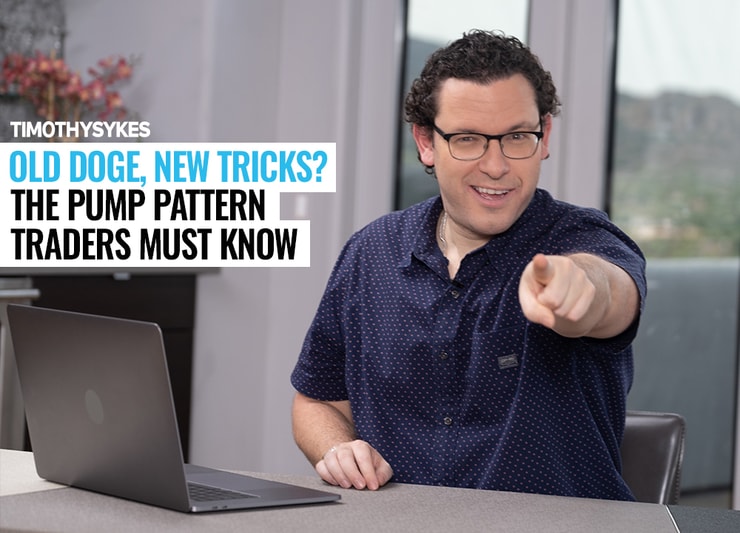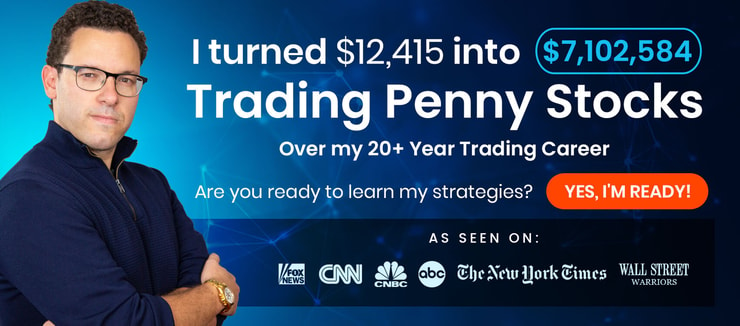Watching the price action on Monday and Tuesday, I realized that the Dogecoin (DOGE) chart is a prime example of a repeatable pattern: the penny stock pump.
Especially the celebrity penny stock pump.
I’ve seen over and over again: celebrities and icons using their influence to pump stocks.
That hasn’t changed in the 20+ years I’ve been trading. Except maybe with social media, more people blindly follow influence…
It’s also more frequent. It seems everyone on FinTwit is a stock expert these days.
But what’s more interesting is that the rise and fall of DOGE perfectly illustrate four crucial trading rules you must ALWAYS follow. More on that in a bit.
These rules keep running through my head as I watch the candles on the DOGE chart tick deeper into the red.
As I write this, it’s 70% off its highs (down 50% percent just this week). The DOGE chart looks exactly like some other charts I know well — promoted penny stocks that all CRASHED while unsuspecting newbies got burned.
Now #dogecoin is down 50% in a week, there's just no reason to hold through such devastation & all this #DiamondHands bullshit is 100% wrong as the #stimuluschecks funded volatility is a short-term blip in the markets. Sadly, an entire generation has learned the wrong lessons
— Timothy Sykes (@timothysykes) June 22, 2021
This is why I teach my students to recognize patterns early on … But too many traders don’t get the memo in time. And they lose big. I hate to see it.
It’s the same pattern in DOGE. And no, it doesn’t matter that it’s crypto and not a penny stock. Desperate bag holders rush online to brag that the literal joke of a cryptocurrency is still headed “to the moon!”
I may poke fun, but let me be clear — I have absolutely nothing against Dogecoin.
This is a history lesson in the making.
Table of Contents
1. Always Sell Into Strength
I posted this tweet on Monday…
NEVER FORGET TO SELL INTO STRENGTH! #dogecoin down 70%+ now since #DogeFather on TV, very reminiscent of celebrity pumps like Bieber, Shaq, Tiger Woods, all of whom publicly promoted penny stocks that all crashed & burned, leaving ALL their fans holding the bag. #learnfromhistory
— Timothy Sykes (@timothysykes) June 21, 2021
If you’re massively green on a position, and momentum is on your side, you must take profits.
ALWAYS sell into strength.
This rule will never change for my Trading Challenge students, and it also applies to the DOGE situation…
From mid-April to the first week of May, DOGE went on an absolute tear to the upside.
On April 6, DOGE was trading for just over 6 cents. By May 7, DOGE hit a staggering all-time high of 72 cents.
From the bottom, this move would give you 10 times your money. Remember that. It’s a repeatable pattern.
Over and over, penny stocks crash after delivering 10x gains from the bottom. I now see similar moves in crypto. (BTW, I’m not the only one who sees penny stock patterns in crypto … Check out what Matthew Monaco is up to these days.)
As DOGE’s price continued higher, retail traders started calling “HODL to $1!”
This is where many experienced traders took a serious pause…
This trading ‘approach’ can lead to huge losses. What’s worse, it can destroy confidence.
Too many traders focus only on the money. That’s a mistake, whether holding and hoping for more or being unable to cut a loss…
It can happen to anyone. It’s easy to get caught up in the money. But you must remember the big picture. If you don’t, you can damage your trading mindset.
And confidence is crucial in the long term.
I’ve seen newbie traders freeze up after making one critical trading error. Don’t be this trader.
Instead, learn to sell into strength. ESPECIALLY if a stock is nearing 10x from its bottom…
If you’re lucky enough to make huge gains off of a crap penny stock or a highly speculative altcoin that was created as a joke … take the money and run!
Dear all $RSHN $GGII $LTNC $OZSC $ENZC $AITX $OPTI $HMBL $ALPP $ABML $VPER $HQGE $GTLL #dogecoin #bitcoin bagholders, let this be a lesson to TAKE YOUR DAMN PROFITS INTO STRENGTH AND DON'T GET GREEDY! It saddens me how much $ is wasted due to greed/lack of discipline! #singleswin
— Timothy Sykes (@timothysykes) June 22, 2021
2. Cut Losses QUICKLY
This is my #1 rule. I had to learn it the hard way. (Learn more about that in my book here.) But I don’t want any trader to have to go through that same painful experience.
Learn this now: You’ll likely never buy the bottom and sell the exact top. And you’ll make mistakes throughout your entire career.
It still happens for me. I still take losses. There’s no such thing as perfect trading.
But you can choose to learn from your mistakes. Often, those are the most powerful lessons.
And you must learn to cut losses quickly.
It can mean the difference between living to fight another day or blowing up your account. Let’s look at an example with a hypothetical DOGE trade…
Say you’re unfortunate to get caught up in FOMO and buy DOGE at 70 cents.
As it climbs to 72 cents, you feel excited. Next stop, $1!
But then the unthinkable happens … DOGE begins to sell off following Elon Musk’s SNL appearance.
It dips down below 69 cents, then 65 cents, then 60 cents … and that excitement you felt turns to dread.
You realize you’ve made a big mistake. That’s OK. Don’t panic.
Take a deep breath, stay disciplined, and carefully consider your options…
Do you listen to the greedy HODLers and hope for a reversal? Or do you bite the bullet and cut your losses before they get worse?
Of course you cut losses quickly!
More Breaking News
- Rigetti Computing: From Surging Prices to an Uncertain Future
- Is It Too Late to Jump on Ambev S.A.’s Rising Stock?
- Is Archer Aviation Inc. Up for a Steadier Flight Following Key Partnerships?
As soon as your position goes red, cut it and move on.
3. Buy the Rumor, Sell the News

Stocks and cryptos regularly trade around big news. And often, the market anticipates the news will affect the price action one way or another.
These can be trading opportunities or traps, depending on your approach.
One key to ‘buy the rumor, sell the news’ catalysts is knowing that most traders get in early. DOGE is an excellent example of how this plays out.
Look at what happened with Musk’s appearance on “Saturday Night Live.” That marks DOGE’s all-time high. Look at DOGE’s chart. Its price started dropping after Musk’s SNL performance.
The catalyst was already priced into DOGE.
This is why you have to learn to ride the hype. Never fall for it.
My apologies to all #dogecoin bagholders but I warned at the time #ElonMusk went on SNL it was a buy the rumor, sell the news event. Now down 75% so hopefully you guys learned…sadly the hard way for too many 🙁 Read this blog post https://t.co/ZeJrFbuecp ignore the #DogeFather https://t.co/igbKRmUlzY
— Timothy Sykes (@timothysykes) June 21, 2021
Had more traders understood that the rumor had more appeal than the actual news, we probably wouldn’t have so many DOGE bag holders.
But it’s easy for greed to get in the way.
Now, traders have billions of dollars tied up in DOGE as they desperately hold and hope for a comeback. That brings me to my last point…
4. Never Hold and Hope

In the crypto community, it’s almost required to “HODL” coins that are down 50% or more.
Sellers and profit-takers are regularly shamed on Reddit and Twitter — when in reality they should be congratulated for booking a win, even small gains. Remember, small gains add up, but only if you cut losses quickly.
And why tie up your trading capital in losing positions? Again, it messes with your mindset and confidence. The pattern is the same over and over — dot-com stocks, weed stocks, meme stocks.
Bullishness builds for weeks or months and too many traders get sucked into the excitement of the moment.
But the crash is inevitable. Look at GameStop (NYSE: GME). Look at any penny stock that follows the supernova pattern. Learn my 7-step pennystocking framework to better understand the pattern.
It is not a question of if these celebrity pumps will crash … It’s a question of when.
But for some reason, many traders hold all of their shares through huge drops. Holding anything down 70% is a huge mistake. I’d cut out WAY before that.
Then these traders try to draw comparisons to other charts, where buying the dip was ‘rewarded.’ But most of the time, those charts have nothing to do with penny stock pumps or crypto.
And had they learned to cut their losses quickly, they wouldn’t be in the position of holding and hoping in the first place.
So NEVER hold and hope. It is a sucker’s game.
Pretty funny how much hate I'm getting from #Bitcoin & #dogecoin bag holders who don't realize it IS possible to make MILLIONS OF PERCENT & still lock in the profits too like one of my top https://t.co/occ8wKmlgm students @mono_trader has done. Also check out the $WSRC run today! https://t.co/tlQKGGYPMg
— Timothy Sykes (@timothysykes) June 22, 2021
Pump Patterns: The Bottom Line
Want to trade? You need an education. I don’t care whether you want to trade penny stocks, crypto, or options. You must know the patterns and history.
If you trade a pump, there’s no avoiding the crash on the other end — unless you have the skills and knowledge to sell into strength or cut your losses.
This is why history matters and why I teach. Study the past!
I’ve seen it so many times.
That’s why when DOGE came around, my students were prepared. We knew exactly how the chart was going to pan out because we’ve seen this pattern time and time again.
If you’re reading this and thinking, “How can I learn to recognize these patterns?” — apply to my Trading Challenge.
I teach my students all my rules for smart trading and how to be self-sufficient.
No matter what … be aware, stay disciplined, and always follow the four golden rules when trading pumps.
What do you think of DOGE? Let me know in the comments — I love to hear from you.



Leave a reply